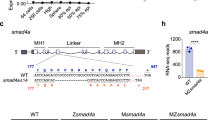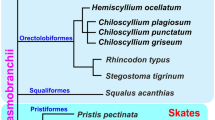Abstract
Signalling by the transforming growth factor-β (TGF-β) superfamily of proteins depends on the phosphorylation and activation of SMAD proteins by heteromeric complexes of ligand-specific type I and type II receptors with serine/threonine-kinase activity1. The vertebrate SMAD family includes at least nine members, of which Smad2 has been shown to mediate signalling by activin and TGF-β2,3,4,5. In Xenopus, Smad2 can induce dorsal mesoderm, mimicking Vg-1, activin and nodal2,4. Here we investigate the function of Smad2 in mammalian development by generating two independent Smad2 mutant alleles in mice by gene targeting. We show that homozygous mutant embryos fail to form an organized egg cylinder and lack mesoderm, like mutant mice lacking nodal6,7 or ActRIB, the gene encoding the activin type-I receptor8. About 20 per cent of Smad2 heterozygous embryos have severe gastrulation defects and lack mandibles or eyes, indicating that the gene dosage of Smad2 is critical for signalling. Mice trans-heterozygous for both Smad2 and nodal mutations display a range of phenotypes, including gastrulation defects, complex craniofacial abnormalities such as cyclopia, and defects in left–right patterning, indicating that Smad2 may mediate nodal signalling in these developmental processes. Our results show that Smad2 function is essential for early development and for several patterning processes in mice.
This is a preview of subscription content, access via your institution
Access options
Subscribe to this journal
Receive 51 print issues and online access
$199.00 per year
only $3.90 per issue
Buy this article
- Purchase on Springer Link
- Instant access to full article PDF
Prices may be subject to local taxes which are calculated during checkout




Similar content being viewed by others
References
Heldin, C. H., Miyazono, K. & ten Dijke, P. TGF-β signalling from cell membrane to nucleus through SMAD proteins. Nature 390, 465–471 (1997).
Graff, J. M., Bansal, A. & Melton, D. Xenopus Mad proteins transduce distinct subsets of signals for the TGFβ superfamily. Cell 85, 479–487 (1996).
Macias-Silva, M. et al. MADR2 is a substrate of the TGFβ receptor and its phosphorylation is required for nuclear accumulation and signaling. Cell 87, 1215–1224 (1996).
Baker, J. C. & Harland, R. M. Anovel mesoderm inducer, Madr2, functions in the activin signal transduction pathway. Genes Dev. 10, 1880–1889 (1996).
Zhang, Y., Feng,, We, R. & Derynck, R. Receptor-associated Mad homologues synergize as effectors of the TGF-β response. Nature 383, 168–172 (1996).
Conlon, F. L. et al. Aprimary requirement for nodal in the formation and maintenance of the primitive streak in the mouse. Development 120, 1919–1928 (1994).
Iannaccone, P. M., Zhou, X., Khokha, M., Boucher, D. & Kuehn, M. R. Insertional mutation of a gene involved in growth regulation of the early mouse embryo. Dev. Dyn. 194, 198–208 (1992).
Gu, Z. et al. The type I activin receptor ActRIB is required for egg cylinder organization and gastrulation in the mouse. Genes Dev. 12, 844–857 (1998).
Mountford, P. et al. Dicistronic targeting constructs: reporters and modifiers of mammalian gene expression. Proc. Natl Acad. Sci. USA 91, 4303–4307 (1994).
Hogan, B., Beddington, R., Costantini, F. & Lacy, E. in Manipulating the Mouse Embryo 51–73 (Cold Spring Harbor Laboratory Press, New York, 1994).
Tam, P. L. P. & Behrignger, R. R. Mouse gastrulation: the formation of a mammalian body plan. Mech. Dev. 68, 3–25 (1997).
Wilkinson, D. G., Bhatt, S. & Herrmann, B. G. Expression pattern of the mouse T gene and its role in mesoderm formation. Nature 343, 657–659 (1990).
Waldrip, W. R., Bikoff, E. K., Hoodless, P. A., Wrana, J. L. & Robertson, E. J. Smad2 signaling in extraembryonic tissues determines anterior-posterior polarity of the early mouse embryo. Cell 92, 797–808 (1998).
Zhou, X., Sasaki, H., Lowe, L., Hogan, B. L. & Kuehn, M. R. Nodal is a novel TGF-β-like gene expressed in the mouse node during gastrulation. Nature 361, 543–547 (1993).
Varlet, I., Collignon, J. & Robertson, E. J. nodal expression in the primitive endoderm is required for specification of the anterior axis during mouse gastrulation. Development 124, 1033–1044 (1997).
Collignon, J., Varlet, I. & Robertson, E. J. Relationship between asymmetric nodal expression and the direction of embryonic turning. Nature 381, 155–158 (1996).
Lowe, L. A. et al. Conserved left–right asymmetry of nodal expression and alterations in murine situs inversus. Nature 381, 158–161 (1996).
Oh, S. P. & Li, E. The signaling pathway mediated by the type IIB activin receptor controls axial patterning and lateral asymmetry in the mouse. Genes Dev. 11, 1812–1826 (1997).
Hoodless, P. A. et al. MADR1, a MAD-related protein that functions in BMP2 signaling pathways. Cell 85, 489–500 (1996).
Green, J. B., New, H. V. & Smith, J. C. Responses of embryonic Xenopus cells to activin and FGF are separated by multiple dose thresholds and correspond to distinct axes of the mesoderm. Cell 71, 731–739 (1992).
Jones, C. M., Kuehn, M. R., Hogan, B. L., Smith, J. C. & Wright, C. V. Nodal-related signals induce axial mesoderm and dorsalize mesoderm during gastrulation. Development 121, 3651–3662 (1995).
Lagna, G., Hata, A., Hemmati-Brivanlou, A. & Massagué, J. Partnership between DPC4 and SMAD proteins in TGF-β signalling pathways. Nature 383, 832–836 (1996).
Chen, X. et al. Smad4 and FAST-1 in the assembly of activin-responsive factor. Nature 389, 85–89 (1997).
Sirard, C. et al. The tumor suppressor gene Smad4/Dpc4 is required for gastrulation and later for anterior development of the mouse embryo. Genes Dev. 12, 107–119 (1998).
Li, E., Bestor, T. H. & Jaenisch, R. Targeted mutation of the DNA methyltransferase gene results in embryonic lethality. Cell 69, 915–926 (1992).
Laird, P. W. et al. Simplified mammalian DNA isolation procedure. Nucleic Acids Res. 19, 4293 (1991).
Nakao, A. et al. Identification of Smad2, a human Mad-related protein in the transforming growth factor β signaling pathway. J. Biol. Chem. 272, 2896–2900 (1997).
Kaufman, M. H. The Atlas of Mouse Development(Academic, San Diego, 1992).
Wilkinson, D. G. In Situ Hybridixation: A Practical Approach(Oxford University Press, London, 1992).
Acknowledgements
We thank E. Robertson for nodallacZ mice; P. Ten Dijke for Smad2 antibody; A. Smith for pGT1.8Iresβgeo; P. Oh for help with whole-mount in situ hybridization; H. Lei, M. Okano and L. Yu for technical assistance; and Z. Gu and T. Gridley for comments on the manuscript. This work was funded by Bristol Myers-Squibb (E.L.) and a postdoctoral fellowship from the Japan Society for the Promotion of Science (M.N.).
Author information
Authors and Affiliations
Corresponding author
Rights and permissions
About this article
Cite this article
Nomura, M., Li, E. Smad2 role in mesoderm formation, left–right patterning and craniofacial development. Nature 393, 786–790 (1998). https://doi.org/10.1038/31693
Received:
Accepted:
Issue Date:
DOI: https://doi.org/10.1038/31693
This article is cited by
-
Soluble dipeptidyl peptidase-4 induces epithelial–mesenchymal transition through tumor growth factor-β receptor
Pharmacological Reports (2023)
-
Pathway analysis of smoking-induced changes in buccal mucosal gene expression
Egyptian Journal of Medical Human Genetics (2022)
-
Pharmacological inhibition of HDAC6 improves muscle phenotypes in dystrophin-deficient mice by downregulating TGF-β via Smad3 acetylation
Nature Communications (2022)
-
Genetics of Transposition of Great Arteries: Between Laterality Abnormality and Outflow Tract Defect
Journal of Cardiovascular Translational Research (2021)
-
TGF-β and WNT signaling pathways in cardiac fibrosis: non-coding RNAs come into focus
Cell Communication and Signaling (2020)
Comments
By submitting a comment you agree to abide by our Terms and Community Guidelines. If you find something abusive or that does not comply with our terms or guidelines please flag it as inappropriate.



